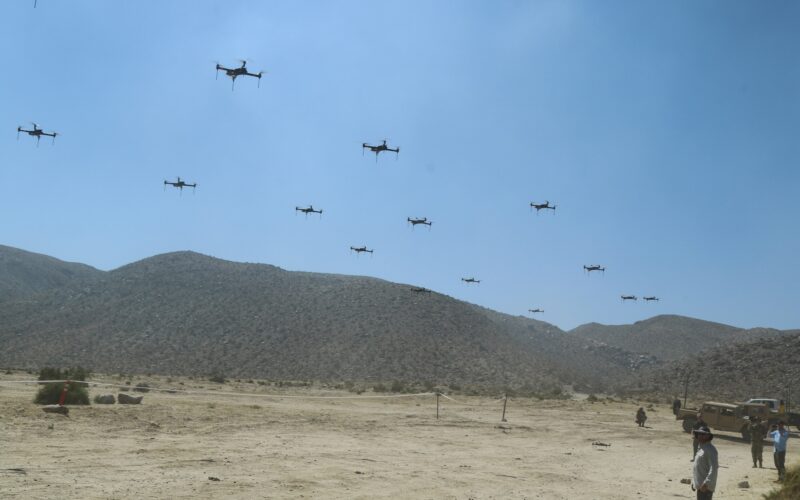In a move aimed at maintaining its strategic advantage in the Indo-Pacific region, specifically in the face of China’s military buildup, the US Department of Defense has introduced a new initiative known as “Replicator.”
Deputy Secretary of Defense Kathleen Hicks revealed the initiative on August 28, 2023, during her address at the National Defense Industrial Association’s Emerging Technologies for Defense conference in Washington DC, United States.
Directly naming China as a military adversary of the United States, the Replicator initiative is designed to address a key challenge posed by the rapid buildup of the People’s Liberation Army (PLA): its sheer “mass.”
For years now, the PLA has stood as the world’s largest military force, boasting over 2 million servicemembers. Its mass, however, extends beyond its number of personnel.
Evolving significantly since the beginning of the century, China’s People’s Liberation Army Navy (PLAN) has transformed from a modest green-water maritime force into a blue-water fleet, with the capacity to project China’s power on a global stage.
In September 2020, the US Department of Defense acknowledged that its own naval force had finally been numerically surpassed, with 350 Chinese ships and submarines against the US Navy’s 2020 fleet of roughly 293 ships.
Similarly, the People’s Liberation Air Force commands a fleet of approximately 2,000 combat aircraft, among which it operates one of the only fifth-generation fighter jets in the world, the indigenously developed J-20.
Numerically surpassed, the United States aims to outmatch its adversaries by relying on innovation, strategic thinking, and technology.
“We’ve all seen in Ukraine how emerging tech developed by commercial and non-traditional companies — from Starlink to Switchblades to commercial imagery — can be decisive in defending against modern military aggression,” Hicks highlighted.
Attritable systems transforming modern warfare
Shortly after making their debut in the commercial market, small aerial drones swiftly asserted their presence on the battlefield, challenging the dominance of larger manned systems. As early as 2014, the Islamic State incorporated small commercially available quadcopters, specifically DJI Phantom 3 and 4 models, for reconnaissance purposes, before eventually transforming them into suicide drones using improvised warheads made from grenades.
In a brief but intense conflict between Armenia and Azerbaijan over Nagorno-Karabakh in November 2020, the latter demonstrated a heavy reliance on Israel-manufactured loitering munitions, effectively destroying 59 Armenian vehicles, spanning from trucks and artillery units to even tanks. This engagement also provided a glimpse of the Turkish Bayraktar TB2’s effectiveness in targeting expensive platforms, namely armored vehicles, and anti-aircraft systems.
The invasion of Ukraine by Russia further solidified the role of attritable systems as a leveling force on the battleground. Once again, the TB2 showcased its efficiency by containing the initial Russian military offensive. At the infantry level, compact systems also demonstrated their operational prowess, providing real-time reconnaissance and extending the reach of soldiers.
On April 21, 2022, the United States introduced a fresh package of military aid for Ukraine, which prominently featured 121 “Phoenix Ghost tactical drones.” These drones resemble the Switchblade miniature loitering munition already integrated into various branches of the US military. However, the development of Phoenix Ghost was expedited and tailored to the specific requirements of the Ukrainian Armed Forces in the Donbas region.
Finally, perhaps representing the epitome of attritable systems, the Melbourne-based company SYPAQ delivered its Corvo Precision Payload Delivery System or PPDS to the Ukrainian military in May 2023. These fixed-wing UAVs are predominantly constructed from a material akin to cardboard, rendering them low-cost and expendable platforms. Designed primarily for small cargo deliveries, speculative reports suggest they might have been used as a swarm to target Kursk Vostochny Airfield in Russia on August 27, 2023.
Replicator: US innovation against China’s numbers
“We’ve already been investing in attritable autonomous systems […]: self-piloting ships, uncrewed aircraft, and more,” Hicks said. “Since we need to break through barriers and catalyze change with urgency, we’ve set a big goal for Replicator: to field attritable autonomous systems at scale of multiple thousands, in multiple domains, within the next 18-to-24 months.”
An envelope of $5.8 billion has been requested for the Replicator program. This strategy is anticipated to enable the US not only to counterbalance the sheer size of potential adversaries like the PLA but also to indirectly mitigate the material limitations posed by equipment currently in use within the US armed forces, which are frequently characterized by high procurement and operational costs.
As such, it differs from other ongoing initiatives relying on aerial drones, such as the US Air Force Next-Generation Air Dominance program and its Collaborative Combat Aircraft. This program aims to develop larger, complex drones with fighter-like capabilities, such as the XQ-58A Valkyrie, to have them act as a ‘loyal wingman’ to manned aircraft. Though slated to be less expensive than their manned counterparts, these systems will remain costly.
“We must ensure the PRC leadership wakes up every day, considers the risks of aggression, and concludes, “today is not the day” — and not just today, but every day, between now and 2027, now and 2035, now and 2049, and beyond,” Hicks said. “Innovation is vital to how we do that.”
Nonetheless, for this technological strategy to yield operational advantages significant enough to counterbalance the numerical strength of the Chinese military, it must outpace advancements in similar technologies.
Yet, numerous public demonstrations have indicated China’s keen interest in harnessing autonomous drone capabilities, particularly in the form of collaborative swarms. For example, in a study published in Science Robotics in 2022, Chinese researchers from Zhejiang University demonstrated a swarm of drones that could fly together autonomously in an unfamiliar and constraining space such as a forest.

